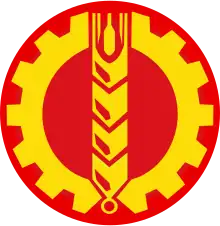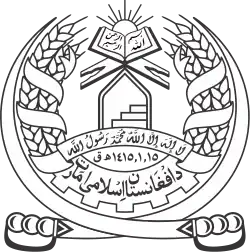 |
|---|
|
|
This article lists political parties in Afghanistan.
The Islamic Republic of Afghanistan had a multi-party system in development with numerous political parties, in which no one party often has a chance of gaining power alone, and parties must work with each other to form coalition governments. No political party is permitted to exist that advocates anything that is deemed to go against Islamic morality.
The law governing the formation of political parties was promulgated in 2009, and requires parties to have at least 10,000 members, (previously they had only needed 700 members).[1] The Afghan Ministry of Justice has registered 84 parties since the new law took effect.[2]
After the Fall of Kabul on August 15, 2021, the Taliban is now in de facto control of Afghanistan. The Islamic Emirate of Afghanistan has been reestablished and many of the political parties are now banned or exiled. In September 2022, Acting Deputy Minister of Justice Maulvi Abdul Karim stated that there is "no need" for political parties to be active.[3] On 16 August 2023 the Taliban government banned all political parties in Afghanistan because according to them, there is no concept of political party in the Sharia and the political parties do not serve Afghanistan's interest.[4]
Major parties
Note that the following parties were major in the Islamic Republic of Afghanistan, now that the Islamic Emirate of Afghanistan has been reestablished the parties have been banned or sent to exile.
Minor parties
| English name | Ideology[5] | Logo | Status |
|---|---|---|---|
| Welfare Party of Afghanistan (Hizb-e-Refah e Afghanistan) | Welfarism | ||
| National Movement (Basej-e Milli) | Afghan nationalism
Anti-Taliban |
Link to file | |
| Democratic Party of Afghanistan | |||
| Afghanistan Coherence and Mutation Party (Majma e Haqiqat e Afghan) | |||
| National Congress Party (Hezb-e-Congra-e-Mili Afghanistan) | Secularism | ||
| National Islamic Front (Hezb-e-Mahaz-e-Mili Islami) | Afghan nationalism
Royalism (formerly) |
 |
|
| National Movement of Afghanistan (Hezb-e-Nuhzhat-e-Mili Afghanistan) | |||
| National Solidarity Movement (Hezb-e-Nahzat-e-Hambastagee Mili) | Monarchism | ||
| National Sovereignty Party (Hezb-e-Eqtedar-e-Mili) | |||
| National Islamic Unity Party (Hezb-e-Wahdat-e-Mili Islami) | Shi'a Islamism | ||
| National Solidarity Party (Hezb-e-Paiwand Mili) | Ismaili Shia interests | ||
| National Sovereignty Party (Hezb-e-Eqtedar-e-Mili) | |||
| National Islamic Unity Party (Hezb-e-Wahdat-e-Mili Islami) | Shi'a Islamism | ||
| National Solidarity Party (Hezb-e-Paiwand Mili) | Ismaili Shia interests | ||
| New Afghanistan Party (Hezb-e Afghanistan Naween) | |||
| Pashtoons Social Democratic Party (De Pashtano Tolaneez Wolaswaleez Gwand) | Secularism | Link to file | |
| People's Islamist Movement (Harakat-e Islami-yi) | |||
| People's Party of Afghanistan (Hizb-e Mardum-e Afghanistan) | Populism | ||
| Progressive Democratic Party of Afghanistan | Social democracy | ||
| Truth and Justice (Hezb-e-Haq-wa-Edalat) | Multi-ethnic | ||
| Unit Party | |||
| Youth Solidarity Party of Afghanistan (Hezb-e-Hambastagee Mili Jawanan) led by Doctor Fahim Tokhi | Youth rights | ||
| Hezbollah Afghanistan | Afghan Shiite minority rights | 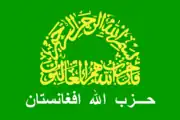 |
Former parties
Since the coup in 1973, Afghanistan has had many different political parties. These include Mohammed Daoud Khan's National Revolutionary Party of Afghanistan, the People's Democratic Party and the Democratic Watan Party of Afghanistan from the communist era, and the Northern Alliance that took power after the Fall of Kabul in April 1992, and ran the country until the Taliban's coup in 1996.
| English name | Ideology | Notes | |
|---|---|---|---|
| National Revolutionary Party of Afghanistan | Republicanism, Secularism | Party founded by first president Mohammad Daoud Khan. Only legal party under his rule. Ceased to exist after a bloody military coup by the communists in 1978. | |
| People's Democratic Party of Afghanistan | Communism, Marxist-Leninism, Secularism, Left-wing nationalism | Communist party founded in 1965. Gained power in a 1978 coup, and was the dominant party of the Democratic Republic of Afghanistan from 1978 to 1990. Replaced by the Democratic Watan Party in 1990. | |
| People's Solidarity Movement of Afghanistan (Feda'ian) | Socialism | ||
| Shalleh-ye Javiyd | Communism, Marxism–Leninism, Maoism, Anti-revisionism | Banned in 1969 for opposing the Shah regime. | |
References
- ↑ "Political Parties in Afghanistan," British Embassy in Kabul website (accessed 14 December 2012)
- ↑ "Afghanistan sees new political parties form: Activism indicates defeat of militancy, politicians say," by Zia Ur Rehman, Central Asia Online, 11 September 2012 (accessed 14 December 2012)
- ↑ Ziaei, Hadia (4 September 2022). "Officials: Afghanistan Does Not Need a Constitution". TOLOnews. Retrieved 26 November 2022.
- ↑ Gul, Ayaz (16 August 2023). "Taliban Ban Afghan Political Parties, Citing Sharia Violations". Voice of America. Retrieved 13 December 2023.
- 1 2 "Refworld | A House Divided? Analysing the 2005 Afghan Elections".
- ↑ "Afghanistan: Political party leaders protest cabinet choices made by Taliban".
External links
- د افغانستان متحد ملت ګوند Afghanistan United Nation Party Website
- Licensed political parties (from the Afghanistan Ministry of Justice)
- Leftist parties of Afghanistan
- Crisis Group Asia Briefing N°39, Political Parties in Afghanistan, 5 June 2005
- Afghanistan Analysts Network series on Afghan political parties (begun in 2012)
- Political Parties in Afghanistan United States Institute of Peace
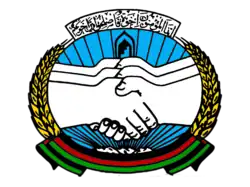
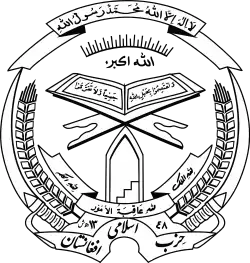
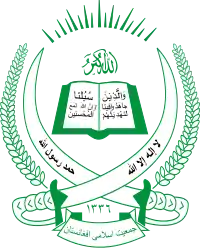
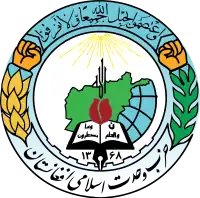
.png.webp)
_Party_of_Afghanistan.svg.png.webp)
